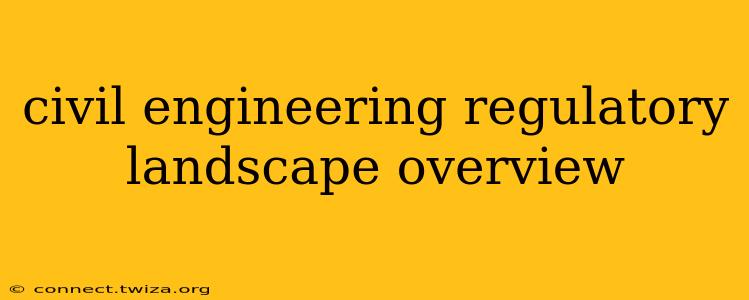The civil engineering profession, responsible for shaping our built environment, operates within a complex and multifaceted regulatory landscape. This overview delves into the key aspects of this landscape, examining the various bodies, regulations, and licensing requirements that govern civil engineering practices globally and within specific regions. Understanding this landscape is crucial for professionals, ensuring compliance and upholding the safety and integrity of public works.
What are the Main Regulatory Bodies for Civil Engineers?
The regulatory bodies governing civil engineering vary significantly by location. Generally, you'll find a mixture of national, regional, and sometimes even local governing bodies. At the national level, many countries have engineering councils or professional associations that set standards, administer licensing exams, and enforce ethical codes of conduct. Examples include the Institution of Civil Engineers (ICE) in the UK, the American Society of Civil Engineers (ASCE) in the United States, and similar organizations worldwide. However, it's important to note that these organizations often play a role in setting standards and providing professional development, but the actual licensing and enforcement usually fall under separate governmental bodies.
Regional or state-level regulatory bodies also exist, often tasked with licensing and enforcing regulations within their specific jurisdictions. These bodies often have the legal power to issue licenses, investigate complaints, and impose sanctions for unprofessional conduct or violations of regulations.
What are the Key Regulations Governing Civil Engineering Projects?
Regulations governing civil engineering projects are extensive and diverse, covering aspects like:
- Building Codes and Standards: These codes define minimum standards for design, construction, and materials, ensuring structural integrity and safety. Examples include the International Building Code (IBC) widely adopted in the United States, and various national building codes in other countries.
- Environmental Regulations: These address potential environmental impacts of projects, requiring environmental impact assessments (EIAs), permits, and adherence to pollution control measures. Agencies like the Environmental Protection Agency (EPA) in the U.S. play a significant role here.
- Safety Regulations: These regulations prioritize worker safety and public safety during construction and operation of civil engineering projects, often referencing Occupational Safety and Health Administration (OSHA) standards in the U.S. or their equivalents in other countries.
- Accessibility Regulations: Many countries have laws promoting accessibility for people with disabilities in buildings and public spaces. The Americans with Disabilities Act (ADA) in the United States is a prime example.
- Zoning Regulations: These local regulations govern land use, building heights, density, and other aspects of project development.
What Qualifications are Needed to Become a Licensed Civil Engineer?
The qualifications required to become a licensed civil engineer vary by jurisdiction but typically include:
- Education: A four-year bachelor's degree in civil engineering from an accredited institution is usually the minimum requirement.
- Examination: Passing a professional engineering exam is typically a mandatory step. This often involves a Fundamentals of Engineering (FE) exam followed by a Principles and Practice of Engineering (PE) exam, which is usually specialized in a particular area of civil engineering (e.g., structural, geotechnical).
- Experience: Accumulating several years of supervised experience under licensed engineers is usually necessary before receiving a full license. The specific requirements for experience vary significantly by jurisdiction.
How Does the Regulatory Landscape Impact Project Costs and Timelines?
The regulatory landscape significantly impacts both project costs and timelines. Compliance with regulations requires additional time and resources, leading to higher project costs. The complexity of navigating various regulations and obtaining necessary permits can also prolong project timelines. Effective project management and early engagement with relevant regulatory bodies are crucial for minimizing these impacts.
What are the Common Penalties for Non-Compliance?
Penalties for non-compliance with civil engineering regulations can be severe and range from fines and license suspension to legal action and criminal charges in cases of serious negligence or misconduct. The specific penalties depend on the nature and severity of the violation and the relevant jurisdiction.
How are Emerging Technologies Affecting the Regulatory Landscape?
Emerging technologies, such as Building Information Modeling (BIM), drones, and artificial intelligence, are transforming civil engineering practices. Regulatory bodies are adapting to these changes, developing new guidelines and standards to address the unique challenges and opportunities these technologies present. The integration of these technologies also requires careful consideration of data privacy, security, and liability issues.
This overview provides a broad introduction to the complex regulatory landscape of civil engineering. It's crucial for professionals to stay updated on relevant regulations within their jurisdictions to ensure compliance and uphold the highest standards of safety and professional ethics. Always consult with relevant authorities and legal professionals for specific guidance.
